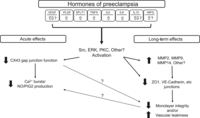Vascular adaptation in pregnancy and endothelial dysfunction in preeclampsia
- D S Boeldt and
- I M Bird⇑
- Department of Ob/Gyn, Perinatal Research Laboratories, University Wisconsin – Madison, Madison, Wisconsin, USA
- Correspondence should be addressed to I M Bird; Email: imbird{at}wisc.edu
-
Figure 1
Proposed mechanism of endothelial dysfunction in preeclampsia. A diverse array of inflammatory hormones are altered in the circulation of late-term PE pregnancies compared with normal pregnancies. Together, these result in activation of kinase signaling pathways such as Src, ERK, PKC and possibly others. Activation of these pathways results in both acute and long-term changes at the level of the plasma membrane. Acutely, closure of CX43 alone results in immediate endothelial dysfunction by reducing the capacity of endothelial cells to coordinate Ca2+ responses needed to stimulate production of vasodilators (NO, PGI2). Longer term, further damage to cell junctional proteins such as ZO1 and VECadherin (by altered turnover or degradation by MMPs) causes a reduction in cell endothelial monolayer integrity and even vessel leakage (edema).
- © 2017 Society for Endocrinology












